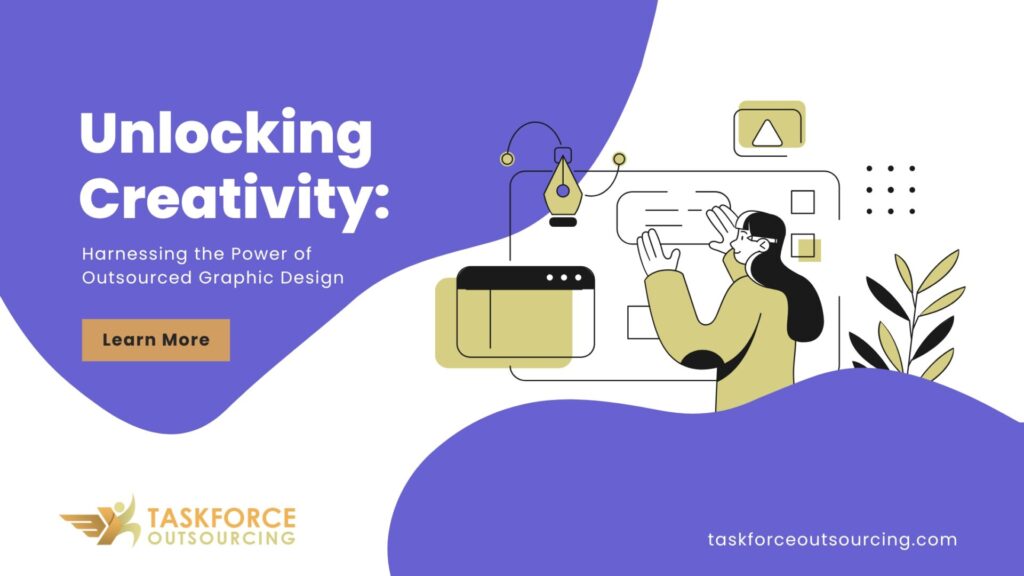A brand’s visual representation plays a crucial role in the dynamic world of modern business. Graphic design is about storytelling, creating a brand identity, and fostering a connection with the audience. In this digital era, businesses are increasingly turning to outsourcing as a strategic approach to meet their graphic design needs.
Contents
- 1 The Significance of Outsourced Graphic Design
- 2 Unlocking Creativity Through Outsourcing
- 3 Choosing the Right Outsourcing Partner
- 4 Streamlining Communication in Outsourced Projects
- 5 Key Collaboration Tools for Outsourcing Graphic Design
- 6 Technologies for Seamless Collaboration
- 7 Overcoming Challenges in Outsourced Graphic Design
- 8 Strategies for Maintaining Quality
- 9 Building Brand Trust: Effective Tactics for Consistent Branding
- 10 Measuring Success: Key Performance Indicators
- 11 Conclusion
The Significance of Outsourced Graphic Design
Outsourcing graphic design is no longer a novel concept, but rather a strategic choice embraced by businesses globally. The advantages are compelling – cost-effectiveness, access to a diverse talent pool, and the flexibility to scale design efforts. Unlike maintaining an in-house design team, outsourcing allows businesses to tap into the expertise of creative professionals without the associated overhead costs. This shift in approach has proven to be a game-changer, especially for businesses seeking innovative and visually captivating designs.
Unlocking Creativity Through Outsourcing
Diverse Perspectives in Design
One of the primary benefits of outsourcing graphic design is the injection of diverse perspectives into creative projects. When collaborating with a global talent pool, businesses gain access to designers with varied cultural backgrounds and experiences. This diversity brings a richness of ideas and creativity that may not be attainable within the confines of an in-house team. It's a kaleidoscope of creativity, offering fresh angles and unique approaches to design challenges.
Leveraging a Global Talent Pool
Creativity knows no borders, and outsourcing graphic design allows businesses to harness the power of a global talent pool. By engaging with designers from different parts of the world, companies can tap into a reservoir of creativity that transcends geographical boundaries. This global perspective not only introduces innovative design concepts but also ensures that the visual elements resonate with a broader audience.
Choosing the Right Outsourcing Partner

Criteria for selecting an outsourcing partner should include a robust portfolio, proven experience in your industry, and a demonstrated ability to translate brand identity into compelling visuals. Aligning with a partner who shares your values ensures a seamless integration of outsourced designs into the broader narrative of your brand.
Streamlining Communication in Outsourced Projects
Effective Communication Strategies
One of the challenges often associated with outsourcing is communication. How do you convey your brand’s essence to a designer halfway across the globe? Effective communication becomes the linchpin of successful outsourced projects. Utilising collaborative tools, scheduling regular video conferences, and fostering an open channel for feedback are crucial elements in overcoming communication barriers. It’s about creating a virtual workspace where ideas flow freely, ensuring that the creative process remains dynamic and responsive.
Key Collaboration Tools for Outsourcing Graphic Design
A diverse range of collaboration tools is available to support various aspects of graphic design outsourcing, from project planning to final delivery.
Project Management Platforms
Project management platforms provide centralised hubs for organising tasks, assigning responsibilities, and tracking project milestones. These platforms facilitate collaboration among team members, ensuring transparency, accountability, and seamless workflow management.
Communication Tools
Communication tools offer versatile communication channels for team collaboration, including instant messaging, video conferencing, and file sharing. These tools enable real-time communication and foster a collaborative work environment, even across distributed teams.
Design Collaboration Software
Specialised design collaboration software enables designers to collaborate seamlessly on design projects, share files, and provide feedback in a centralised environment. These platforms support version control, design prototyping, and collaborative editing, facilitating efficient collaboration throughout the design process.
Technologies for Seamless Collaboration
Project management platforms, cloud-based storage, and real-time communication tools bridge the geographical gap and facilitate seamless interaction. Businesses can actively participate in the design process, providing feedback and refining concepts in a collaborative digital environment. The result is a fluid and efficient workflow that enhances the overall creative output.

Cloud Storage and File-Sharing Solutions
Cloud storage platforms like Google Drive, Dropbox, and OneDrive offer secure and scalable solutions for storing, sharing, and collaborating on design files and assets. Cloud-based storage enables real-time access to files from anywhere, ensuring seamless collaboration and version control across distributed teams.
Virtual Reality (VR) and Augmented Reality (AR)
Emerging technologies such as virtual reality (VR) and augmented reality (AR) present exciting opportunities for immersive collaboration experiences in graphic design. VR and AR tools enable designers and clients to visualise designs in 3D, explore spatial layouts, and provide feedback in real time, fostering greater creativity and engagement in the design process.
Online Proofing and Feedback Tools
Online proofing and feedback tools facilitate efficient collaboration and iteration on design concepts. These platforms allow stakeholders to annotate, comment, and approve design revisions directly on visual assets, streamlining the feedback loop and reducing revision cycles.
Overcoming Challenges in Outsourced Graphic Design
Common Challenges and Mitigation Strategies
While outsourcing brings numerous benefits, it’s not without its challenges. Common issues include differences in time zones, cultural nuances impacting design interpretation, and potential delays in project timelines. However, these challenges are not insurmountable. Mitigation strategies include establishing clear expectations, setting realistic deadlines, and fostering a culture of open communication. Addressing potential challenges proactively ensures that the creative collaboration remains on track.
Strategies for Maintaining Quality
It is imperative that businesses maintain a high standard of visual representation of their brands. To address this, it’s essential to set clear quality standards from the outset. Providing detailed design briefs, conducting regular check-ins, and implementing a robust review process contribute to maintaining the desired quality in outsourced projects. It’s a commitment to excellence that ensures the final designs align seamlessly with the brand’s identity.
Building Brand Trust: Effective Tactics for Consistent Branding
Consistency is essential to the success of any brand, especially when outsourcing graphic design to diverse teams. Businesses must provide clear brand guidelines encompassing colour schemes, typography, and visual elements. Consistency in messaging and visual representation reinforces brand identity across various touchpoints. A unified and coherent brand presence contributes to enhanced brand recall and consumer trust.
The Importance of Clear Brand Guidelines
Clear brand guidelines serve as a roadmap for outsourced designers. They provide a foundation for understanding the brand’s personality, values, and positioning. When designers align with these guidelines, the result is a cohesive visual language that resonates with the target audience. It’s a collaborative effort where outsourced designers become custodians of the brand, ensuring that every design element aligns seamlessly with the established brand identity.
Measuring Success: Key Performance Indicators
Metrics for Evaluating Graphic Design Success
Key Performance Indicators (KPIs) serve as metrics for evaluating the impact of graphic designs on business goals. Metrics such as increased website traffic, higher engagement rates, and improved conversion rates directly correlate to the effectiveness of visual storytelling. Regularly assessing these KPIs provides insights into the ROI of outsourcing graphic design, guiding businesses in refining their creative strategies.
Tracking the Impact of Creative Designs on Business Goals
Outsourced graphic design should contribute directly to achieving business objectives. Whether it’s enhancing brand awareness, driving customer engagement, or boosting sales, the impact of creative designs should be measurable. Tracking the journey from design conceptualization to tangible business outcomes ensures that outsourcing becomes not just a creative endeavour but a strategic investment in achieving overarching business goals.
Conclusion
Visual storytelling is a powerful tool, and outsourcing graphic design is the key to unlocking exceptional creativity. The diverse perspectives, global talent pool, and technological advancements associated with outsourcing transform graphic design from a functional necessity to a strategic asset. Businesses that harness the power of outsourced graphic design not only elevate their brand presence but also position themselves as innovators in their respective industries. It’s a journey of creative collaboration that transcends geographical boundaries and unlocks a world of possibilities.
Frequently Asked Questions (FAQs)
A:Outsourcing graphic design offers advantages such as cost-effectiveness, access to a diverse talent pool, and scalability.
A: Fostering creativity in remote teams involves creating a collaborative environment, leveraging diverse perspectives, and embracing technological tools for creative ideation.
A:Factors include a robust portfolio, industry experience, alignment with brand values, and a demonstrated ability to translate brand identity into visuals.
A: Overcoming communication barriers involves utilising effective communication tools, scheduling regular check-ins, and fostering an open channel for feedback.
A:Yes, small businesses can benefit by accessing specialised skills, cost-effective solutions, and a global talent pool through outsourcing graphic design projects.


